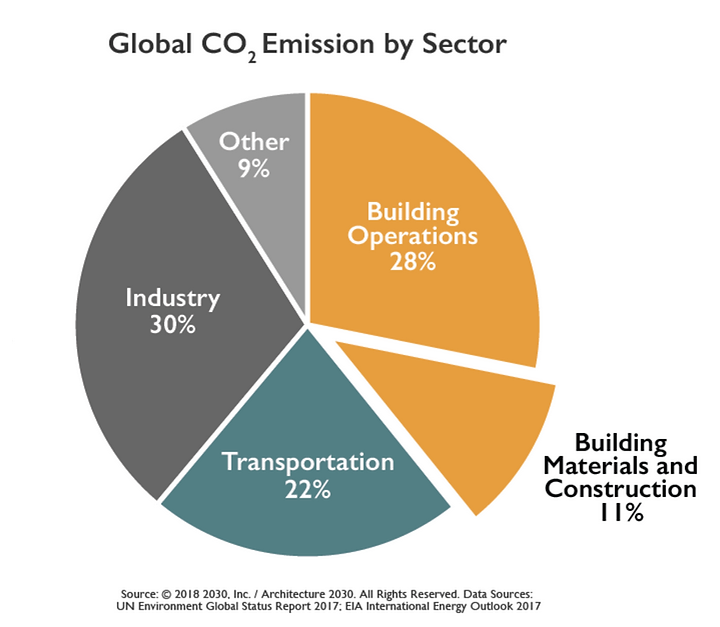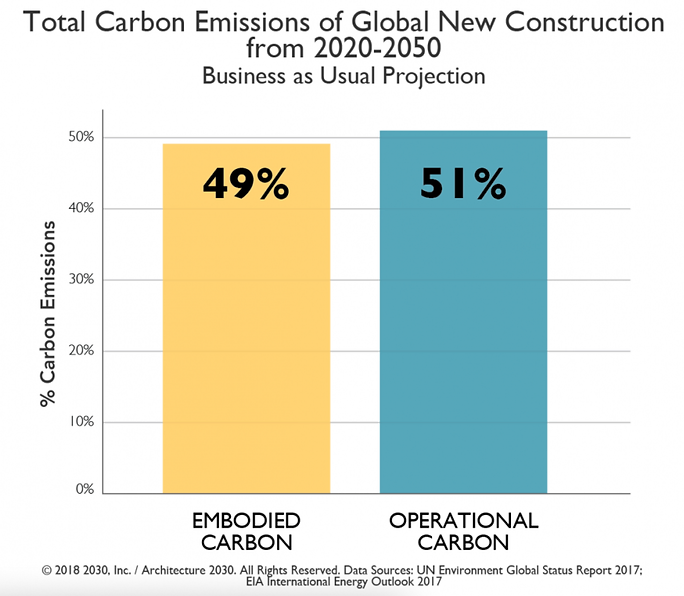The construction industry pumped $900 billion into the U.S. economy and employed more than seven and a half million people mid-way through the first quarter of last year — the strongest market performance since the 2008 recession. Of course, by now we know what was on the other side of that record high: the steepest three-month decline ever recorded. The effects of COVID-19 eroded hard-won gains to the tune of one million jobs and more than $60 billion in GDP lost in the United States alone.
A large majority of the firms who experienced the previous recession had adopted fiscal prudence, and were well-positioned to withstand the contraction. Unfortunately, even though the industry avoided a mass exodus of suppliers, demand dwindled significantly. Those left standing steeled themselves for a long, slow recovery, and competition for projects in COVID-resistant sectors became fierce.
A Second Elephant in the Room
If there was any uncertainty as to whether green building methods were a “must-do” or a “nice-to-have” option, it was dispelled with the results of the 2020 Presidential election. One week into his presidency, Joe Biden made the direction and intensity of climate-related policy changes unequivocally clear. While fossil fuel extraction and consumption were the primary targets of the new administration’s first wave of reforms, it’s evident the construction industry won’t evade the crosshairs for long.

Building materials and construction account for 11% of global CO2 emissions — clinching the number four spot on the worst offenders list. So, as the U.S. rejoins the Paris Agreement and Biden’s newly-assembled Climate Task Force gets to work, fundamental changes to the industry are imminent.
Competing in a Climate-conscious, Mid-pandemic, Slow-to-recover Economic Climate
Excess supply in the market, the duration of the pandemic is uncertain, and global warming has been reinvigorated in daily discourse. How can firms gain a competitive advantage, stay ahead of emission-related regulatory reforms, and position themselves as proactive, climate crisis champions?
Two words: embodied carbon.
Conventional beliefs had considered a building’s embodied carbon — the construction- and material-related emissions over the lifespan of the structure — to be negligible in comparison to its operational carbon footprint. However, recent studies produced findings to the contrary. Based on data from the UN Environment Status Report (2017), and the EIA International Energy Outlook (2017), Architecture 2030 projected between now and 2050, total carbon emissions for new construction will be almost equally distributed between embodied and operational carbon.

Organizations such as the World Green Building Council are working fervently towards achieving net zero carbon emissions within the same time frame. While Green Building’s vision specifies net zero goals for both embodied and operational carbon, their 2019 Embodied Carbon Call to Action Report emphasizes the urgency and potential impact of immediate, coordinated action within the building and construction sector.
Here’s the thing with embodied carbon: unlike emissions generated during building operation, embodied emissions cannot be reduced with technology, upgrades or efficiencies after the fact. From mining, forestry and earthmoving equipment, to coal-fired power stations serving plants and factories, to each vehicle transporting goods throughout the entire supply chain — every kilogram of CO2 emitted in the material manufacturing and construction processes of a building will continually impact the climate for decades to come.
The Road to Net Zero Embodied Carbon Emissions
We’ve identified the opportunity, acknowledged the imperative, and set an ambitious target — so where do we start?
A good place to begin is by taking a look at the carbon footprint variations in traditional building materials. Organic materials such as wood and other plant fibres are considered carbon neutral, as they consume carbon dioxide during growth — effectively offsetting CO2 emitted during the manufacturing process. Inorganic compounds such as steel, aluminum, cement, and vinyl have no such means of offsetting the large amounts of carbon emissions produced by the extensive extraction, refining and manufacturing processes required to convert them from raw state to product.
Organic-good, inorganic-bad doesn’t exactly produce measurable benchmarks. Fortunately, groups such as Building Transparency have developed open source software that makes choosing low carbon options easy. Their Embodied Carbon in Construction Calculator (EC3) tool is free to use, and focuses on “the upfront supply chain emissions of construction materials” (Business Wire, 2021). Insights are powered by third party, verified data (Environmental Product Declaration reports, BIM models) and can be used in the design and/or procurement phases of construction.
Another way to reach net zero embodied carbon emissions is by sequestering carbon dioxide within the building materials themselves.
CarbonCure Technologies – With a mission of eliminating 500 megatonnes of embodied carbon emissions annually, this Canadian startup recently landed about as high-profile of a client as you can get: Amazon’s new Virginia distribution center. Carbon dioxide is removed from the atmosphere and trapped within the cement using a proprietary injection process. Embodied carbon emissions are also lowered because this process increases the strength of the cement, requiring less material to be manufactured and transported.
Magnesium oxy-sulfate board – This innovative alternative to traditional cement board has been estimated to offset 20 – 40% of a building’s embodied carbon emissions. Through a carbon mineralization process, atmospheric CO2 is converted into carbonate mineral. Not only are carbon emissions reduced when carbon dioxide is sequestered within the MgO board, less greenhouse gasses are produced because the process of carbonization takes place at a much lower temperature than traditional cement board. On top of everything, transportation-related CO2 emissions are reduced because MgO boards are lighter than traditional alternatives. Win-Win.
Dr. Doug Brown is a PHD chemist and CTO at ZS2 Technologies, and currently a Director of the Alberta Chapter of the Canadian Green Building Council.


